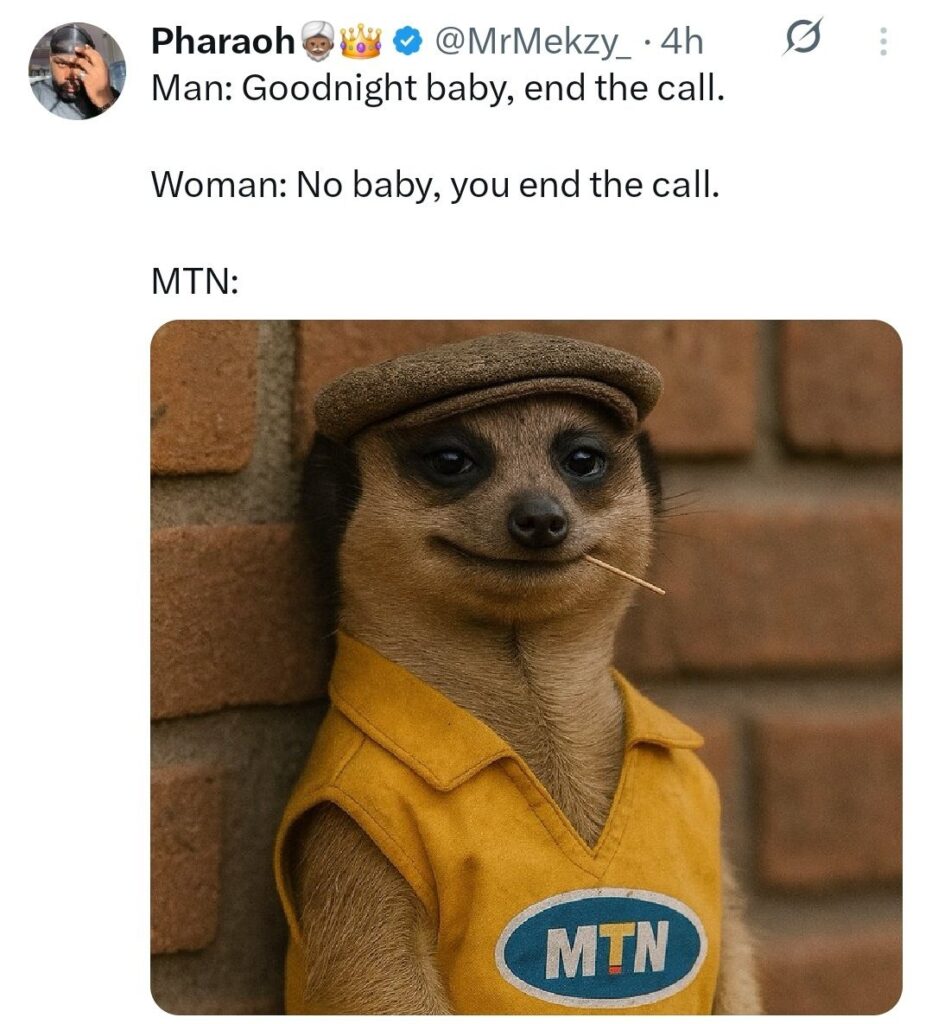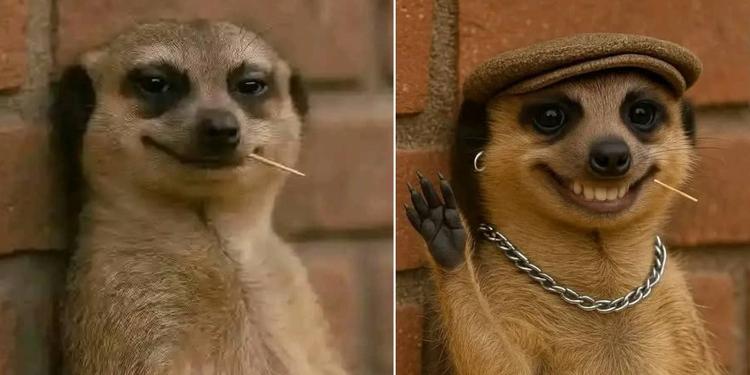Yes, the wide-smiling, toothpick-holding meerkat has taken the internet by storm, replacing former meme favorite Kasongo as the latest face of viral humor.
If you are an average social media user, it is hard not to know that there is a new meme star that is not a celebrity, politician, or influencer. It’s an animal and not even the energetic and unassuming warthog, otherwise called Kasongo. The new meme king is Meerkat.
What started as a humorous social media trend has now evolved into a cultural moment across Africa, including Nigeria, Ghana, Malawi, Uganda, and others.
People are adorning the animal in different wears, pairing it with funny captions, and using it as a symbol of judgment, sarcasm, and quiet observation.
However, beyond the laughter, many are now curious about this unusual meme star. So, what exactly is a meerkat, why are people obsessed with it, and the relationship it has with Kasongo?
- What is a Meerkat?
A meerkat is a small, social animal that looks like a mix between a cat and a squirrel. It belongs to the mongoose family and is native to the dry, open plains and deserts of Southern Africa, especially the Kalahari Desert in Botswana, Namibia, Angola, and parts of South Africa.
They have mottled, sandy-grey coloured fur which helps them blend in with their environment in the African savannah, and are easily recognisable by their upright posture, pointy face, and long, thin tail.
They are usually around 30cm long with a 1kg body weight, but brave and very clever, and know how to protect each other. They live by the saying: “We’re stronger together.” A unique behavior that sets them apart in the wild and has endeared them to netizens across many countries.
- What do meerkats eat?
Meerkats are omnivores – they feed on anything, be it plant or animal. But specifically, they mostly eat insects such as beetles, termites, and grubs. They also eat spiders, scorpions, and sometimes eggs, small birds, or tiny animals. Meerkats are tough — they can handle the poison from some scorpions and snakes without getting sick.
Since they live in dry places, water isn’t always easy to find. But meerkats don’t need much water to survive. When it’s really dry, they stay hydrated by eating things like roots and fruits that hold moisture.
- Are Meerkats a social animal?
Meerkats are extremely social animals, spending a good deal of their day playing together and grooming one another.
They live in matriarchal groups of up to 30 individuals called mobs or gangs. These are comprised of an alpha mating pair, their pups, and other adults. Mob members have rotating designated roles, for instance, non-alpha females who babysit pups or sentries who stand upright on rocks or termite mounds—using their tails for stability—and scan the horizon for predators such as hawks, eagles, or jackals.
However, the meerkat society has its dark side. When the leading female dies and the top position opens up, serious struggles begin. The largest remaining female will take charge, and once she does, her body actually produces more aggressive hormones. She becomes highly hostile toward other females.
She won’t tolerate rivals – any females close to her size get driven out immediately. Even pregnant females aren’t spared from being expelled from the group. So, it’s a tough, competitive world in meerkat society.
- What makes Meerkats unique and endearing animals?
Meerkats have developed physical features and behaviours that help them thrive in the savannah. The complexity of their teamwork sets them apart from many other creatures that share their habitat.
Within a mob, meerkats will take on different roles to keep each other safe. In the burrow, some meerkats stay to watch over any meerkat pups. This is really important as other meerkats from rival mobs will seek out the pups and attack them.
A couple of meerkats will also keep watch for predators above ground whilst the others are foraging for food. These meerkats, called sentries, will find high ground like a tree or a termite mound and sit upright on the lookout for threats.
The duties rotate among the adult meerkats to ensure that all of the meerkats get the chance to forage and find food.
When a meerkat needs to alert the other members of the mob, it uses a series of calls.
These calls have different meanings, each understood by the other members of the mob. They include calls to guard against predators in the sky, predators on land and caring for young. Meerkats can even tell the degree of urgency of the call.
If meerkats can’t run away from a predator, they’ll try to scare the predator away by lying on their back and baring their teeth. They’ll also group together to try and make themselves look like one larger animal by arching their backs and raising their fur.
Also, when feeding their young, meerkats will bring the prey back into the burrow while it is still alive. They then show the young how to eat it safely. For example, if the meerkat has brought a venomous scorpion back to the burrow, they will remove the stinger before eating it.
Despite being small in size, the level of cleverness, intelligence, and ability to protect each other resonates with a typical African who sees them like an energized elder full of wisdom, which sums up why they have become the rising face of memes.
- Enter Meerkats, Out Kasongo
Before now, Warthog, which is also known as Kasongo and crowned as king of the Savannah or Jungle, was used as an internet meme – it was everywhere.
Online videos often depict Kasongo as a playful, somewhat comical figure, interacting with other animals and sometimes being portrayed as a leader or “king” of the jungle. The videos often use music, including the song “Kasongo,” as a soundtrack.
The body of the animal, which is designed to provide it with a variety of defence mechanisms that protect it from predators and unfavourable makes it resonate with internet users as they see it as some sort of superhuman who can weather the storm and roll with the punches.
But, it seems the reign of Kasongo is coming to an end as Meerkats are everywhere on the internet as the face of a meme.
It should be noted that in the wild, warthogs and meerkats developed a helpful partnership that benefits both animals. The meerkats act like cleaning crews for warthogs, picking off ticks and parasites from their skin – this gives the meerkats a meal while giving warthogs a free grooming service. They also look out for each other’s safety, with meerkats using their excellent vision to spot danger while warthogs contribute their strong hearing to detect threats.
Sometimes, warthogs even take shelter from the hot sun in meerkat burrows. This unusual friendship works because they don’t compete for food – warthogs are plant-eaters too large to hunt meerkats, while the quick meerkats are too fast to catch. Their different sizes and habits actually help them cooperate rather than compete, making them perfect natural partners.
While there is no real competition for both animals as meme characters on the internet like in the wild, however, the meerkat is currently the new bride in town, while Kasongo, for now, has stepped aside and relishes in his time as the face of meme.
How did a meerkat become new meme star?
It all began as a cruise on Twitter, where people, especially Nigerians, started editing funny pictures of the Mareeket—putting it in silly situations or giving it human expressions. The internet loved it, and soon, the trend spread to Facebook, Instagram, and Tiktok
Over the past 48 hours, timelines and comment sections have been flooded with memes featuring the now-iconic meerkat image.
Whether it’s its cheeky grin, the way it holds the toothpick, or its unbothered, confident look, one thing is clear: any meme created with a picture of this meerkat is automatically funny to everyone.
“I have been laughing since yesterday,” wrote one user.

Another added, “This meerkat has replaced Kasongo in my meme collection. The facial expression is just elite!”
Some brands have also started using it to market their products as people can’t stop posting the image with hilarious captions, from job interview scenarios and family drama to political jabs and classic humor.
So, next time you see a meerkat, you should know it’s more than just an animal observing its surroundings, but a go-to character for anything sarcastic, petty, or downright ridiculous



















